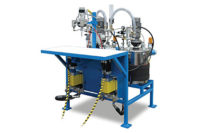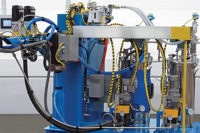Driving Dispensing Systems
Servo motors improve adhesive and sealant application quality and product assembly flexibility.

Adhesive dispensing systems can be difficult to specify when buying new machines and hard to understand when trying to improve existing performance. Two items critical to dispensing performance and resulting product quality are the metering principle and motor drive selection. The metering principle defines the adhesive delivery process, while the motor drive determines the fluid control method for adhesive delivery. This article explains the purpose of servo motor drives used in dispensing adhesives and sealants.

When a dispense cycle is started-whether manually or through automation-the PLC commands the servo drive control to start the dispense cycle profile. The servo drive control then independently controls the closed loop motion of the servo motor, which provides the tightest loop with the best velocity control and the finest position resolution. Position and velocity feedback from the servo motor are monitored by the PLC over the DeviceNet connection and typically displayed on the HMI.
When the dispense cycle profile is completed, the servo drive control signals the PLC and passes this indication to the user’s automation. The PLC then commands the servo drive control to start its “dispense cycle complete” profile to prepare for the next dispense cycle. The PLC coordinates the opening and closing of the material valves with the motion of the metering device that is controlled by the servo motor, monitors the system sensors, and delivers any necessary data and a “dispense ready” signal for the next part.

While it is important to realize capital cost expenditures when buying motor-controlled dispensing equipment, it is equally important to account for the full life cycle financial gains provided by servo drive technology. When dispensing adhesives and sealants onto products, bead placement and size are important factors to consider. Servo motor-driven dispensing equipment usually provides a better return on investment (ROI) than other lower cost drive devices, such as stepper motors, VFD motors, hydraulic drives and pneumatic drives. ROI considers the full life cycle of the production equipment and includes the initial capital cost, less the costs that arise from the increase in production rate and reductions in process setup and programming time, material waste, product repair, scrap, returns, downtime, spare parts, and maintenance.
Servo motors with related controls provide precise and repeatable control of both position and velocity, and their various feedback parameters allow users to closely monitor the dispensing process and detect any abnormalities before they can become major problems. Servo drive technology provides three main advantages in adhesive and sealant dispensing equipment:

Servo drive innovations continue to develop in all industries and provide users with high-quality and easy-to-use dispensing equipment that cannot be made available without servo control devices. For example, a traditional mechanically linked drive and metering cylinders on two-component dispensing machines can now be independently servo driven and controlled by innovative servo drive technology that uses easy-to-understand and highly accurate operator interface controls.
Innovation will continue for servo-driven adhesive dispensing systems due to the requirement for equipment to be integrated with high-end automation, longer maintenance cycles, more precision, higher torque in smaller packages, and lower costs. The benefit for the system supplier with servo-driven equipment is to offer their customers the ability to have fully integrated systems that can be continuously monitored for performance, quickly adjusted for changes in product assembly or new products, provide warnings and fault data to address repairs and prevent scrap, and actually lower total system operating cost.
Servo motor drive technology is recommended when there is a current or future need for:
For more information, contact Sealant Equipment & Engineering, Inc. at 45677 Helm, Plymouth, MI 48170; phone (734) 459-8600; fax (734) 459-8686; email sales@sealantequipment.com; or visit www.sealantequipment.com/servo-moter.htm.
Air-over-oil drive motors are two cylinders where the air cylinder is attached to an oil cylinder with an oil flow control valve to provide smoother and consistent adhesive flow. A single hydraulic cylinder provides the same reliable adhesive flow, but requires a hydraulic power pack that can offer higher pressure and variable flow rates.
Electric drive motors in adhesive dispensing systems provide a higher level of system capability and degree of performance, and may use gear reducers or ball-screws to control the flow rate. AC drive motors are low in cost and use variable-frequency drives to vary the flow. DC stepper motors are usually open-loop and do not know their position, which requires homing upon startup or after emergency stop. AC or DC servo motors are used with a closed-loop encoder, have higher resolution for better position control, and are normally smoother in motion.

Adhesive dispensing systems can be difficult to specify when buying new machines and hard to understand when trying to improve existing performance. Two items critical to dispensing performance and resulting product quality are the metering principle and motor drive selection. The metering principle defines the adhesive delivery process, while the motor drive determines the fluid control method for adhesive delivery. This article explains the purpose of servo motor drives used in dispensing adhesives and sealants.

Servo motor drive technology is recommended when there is a current or future need for dual independent drive meters.
How Does It Work?
In an adhesive dispensing system, the servo motor is controlled by a servo drive control. A programmable logic controller (PLC) communicates with the servo drive control via DeviceNet or equivalent network. At the human-machine interface (HMI) panel, the operator first enters values to create a volume and flow rate for each of the dispense profiles stored in the PLC. The desired profile can be selected remotely by the user’s automation control for the defined part or manually by the operator on the HMI. The shot size and flow rate for this profile is then downloaded by the PLC into the servo drive control.When a dispense cycle is started-whether manually or through automation-the PLC commands the servo drive control to start the dispense cycle profile. The servo drive control then independently controls the closed loop motion of the servo motor, which provides the tightest loop with the best velocity control and the finest position resolution. Position and velocity feedback from the servo motor are monitored by the PLC over the DeviceNet connection and typically displayed on the HMI.
When the dispense cycle profile is completed, the servo drive control signals the PLC and passes this indication to the user’s automation. The PLC then commands the servo drive control to start its “dispense cycle complete” profile to prepare for the next dispense cycle. The PLC coordinates the opening and closing of the material valves with the motion of the metering device that is controlled by the servo motor, monitors the system sensors, and delivers any necessary data and a “dispense ready” signal for the next part.

Servo drive technology continues to grow in product assembly.
Servo Motor Advantages
“Does the adhesive dispensing system have a servo drive motor?” That’s the question being asked today by many manufacturers that require quality parts and reliable production when dispensing adhesives and sealants. Servo drive technology continues to grow in product assembly but is sometimes overlooked by manufacturers due to its initial capital cost compared to non-servo drive equipment.While it is important to realize capital cost expenditures when buying motor-controlled dispensing equipment, it is equally important to account for the full life cycle financial gains provided by servo drive technology. When dispensing adhesives and sealants onto products, bead placement and size are important factors to consider. Servo motor-driven dispensing equipment usually provides a better return on investment (ROI) than other lower cost drive devices, such as stepper motors, VFD motors, hydraulic drives and pneumatic drives. ROI considers the full life cycle of the production equipment and includes the initial capital cost, less the costs that arise from the increase in production rate and reductions in process setup and programming time, material waste, product repair, scrap, returns, downtime, spare parts, and maintenance.
Servo motors with related controls provide precise and repeatable control of both position and velocity, and their various feedback parameters allow users to closely monitor the dispensing process and detect any abnormalities before they can become major problems. Servo drive technology provides three main advantages in adhesive and sealant dispensing equipment:
- Servo drive motors allow users to have preset, multi-segment shot profiles, with each segment having its own material volume and flow rate, as well as the ability to smoothly blend the motion of each segment into the next one in the profile. The user can then select from among their preset profiles before initiating the dispense cycle.
- Servo technology allows the user to continuously vary the material flow rate during the dispense cycle based on a command reference from the process control. This allows the user to either apply a continuous bead of material with varying bead widths, or, conversely, to maintain the same bead width despite changes in the applicator’s linear speed (e.g., when a robot slows down to negotiate a complex curve).
- Servo control has the ability to reliably maintain the commanded volumetric flow rate of material despite changes in the physical conditions of the dispensing system or its environment. Examples of these types of changes are variations in material viscosity-and the related backpressure generated during the dispense cycle-due to such factors as variations in ambient temperature or differences in batches of material; variations in the plant utilities supplied to the dispensing equipment, such as air pressure or electrical voltage; and load changes due to physical wear on the dispensing equipment as it ages. The servo drive simply increases or decreases the amount of current it supplies to the motor as required to maintain the commanded material flow rate, up to the current limits of the drive. If those limits are ever exceeded, the drive generates a fault and stops the cycle, which prevents the user from unknowingly producing out-of-spec parts.

Servo drive innovations continue to develop and provide users with high-quality and easy-to-use dispensing equipment.
Applications
Servo-driven adhesive dispensing systems should be considered when adhesive applications require higher production rates, multiple parts with different beads or volumes, correct bead size and placement, exact amounts of adhesives, fewer product and equipment repairs, and less product scrap for improved quality and lower costs. Many robotic systems already use high-end servo drive technology, but the adhesive dispensing system may use out-of-date pneumatic, hydraulic or electric drive systems that can cause monitoring, communication, and downtime issues.Servo drive innovations continue to develop in all industries and provide users with high-quality and easy-to-use dispensing equipment that cannot be made available without servo control devices. For example, a traditional mechanically linked drive and metering cylinders on two-component dispensing machines can now be independently servo driven and controlled by innovative servo drive technology that uses easy-to-understand and highly accurate operator interface controls.
Innovation will continue for servo-driven adhesive dispensing systems due to the requirement for equipment to be integrated with high-end automation, longer maintenance cycles, more precision, higher torque in smaller packages, and lower costs. The benefit for the system supplier with servo-driven equipment is to offer their customers the ability to have fully integrated systems that can be continuously monitored for performance, quickly adjusted for changes in product assembly or new products, provide warnings and fault data to address repairs and prevent scrap, and actually lower total system operating cost.
Servo motor drive technology is recommended when there is a current or future need for:
- Complex bead paths, tight tolerance beads, precise adhesive volumes
- Multiple parts with different dispensing requirements
- Varying the volume or flow of material during a dispensing cycle
- High-speed automated dispensing
- Integrating a dispensing system with robot automation
- Using the dispensing system meter unit as a seventh robot axis
- Meter systems with dual independent drive meters
- Eliminating a stepper motor’s requirement for “homing” at startup or re-start
- Eliminating a stepper motor’s accumulative position variances
The Best Match
Manufacturers should select the motor drive to match their dispensing application and process. It’s not necessary to settle for a low-technology drive or the only motor drive available for a dispensing system, as it may cost a lot more during production. Manufacturers should define the important product and production requirements for their adhesive and sealant dispensing application, and request that the dispensing equipment manufacturer meet those specifications.For more information, contact Sealant Equipment & Engineering, Inc. at 45677 Helm, Plymouth, MI 48170; phone (734) 459-8600; fax (734) 459-8686; email sales@sealantequipment.com; or visit www.sealantequipment.com/servo-moter.htm.
SIDEBAR: Comparing Motor Drive Technology
The technology for motor drives used in adhesive dispensing systems has evolved from the early pneumatic cylinder drives. A pneumatic drive is still a good choice for shot volume dispensing that has little need for repeatable flow control. When the air pressure varies, the flow rate varies. The need for improvement is the same today as when the air cylinder was upgraded to an air-over-oil drive or hydraulic cylinder.Air-over-oil drive motors are two cylinders where the air cylinder is attached to an oil cylinder with an oil flow control valve to provide smoother and consistent adhesive flow. A single hydraulic cylinder provides the same reliable adhesive flow, but requires a hydraulic power pack that can offer higher pressure and variable flow rates.
Electric drive motors in adhesive dispensing systems provide a higher level of system capability and degree of performance, and may use gear reducers or ball-screws to control the flow rate. AC drive motors are low in cost and use variable-frequency drives to vary the flow. DC stepper motors are usually open-loop and do not know their position, which requires homing upon startup or after emergency stop. AC or DC servo motors are used with a closed-loop encoder, have higher resolution for better position control, and are normally smoother in motion.
Links
Looking for a reprint of this article?
From high-res PDFs to custom plaques, order your copy today!





